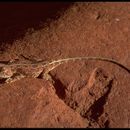en
names in breadcrumbs


Die Taubagame (Tympanocryptis tetraporophora) ist eine Art der Schuppenkriechtiere aus der Familie der Agamen (Agamidae). Sie gehört zu der Gattung Tympanocryptis.
Die Taubagame erreicht eine Gesamtlänge von bis zu 14 Zentimetern. Dabei macht der Schwanz etwas mehr als die Hälfte der Länge aus. Tympanocryptis tetraporophora zeichnet sich durch die rötlich braune Färbung, die feingliedrigen Gliedmaßen und gegebenenfalls vorhandener Querbänderung, die zum Schwanz hin wesentlich deutlicher wird. Die Unterseite der Tiere ist weiß bis hellbeige. Das Trommelfell liegt nicht frei, welches allerdings nicht heißt, dass Tympanocryptis tetraporophora taub ist, wie es der etwas irreführende Name behauptet.
Tympanocryptis tetraporophora, stammt aus Australien und bewohnt hauptsächlich New South Wales, West-Australia, Kimberley-Division, Victoria, Queensland, Kimberley-Division, South Australia und Northern Territory. Die Taubagame ist ein Halbwüsten- und Steppenbewohner. Dort herrschen Temperaturen von 25° bis zu 50 °C.
Die Taubagame ist Ansitzjäger und ernährt sich überwiegend von Insekten, selten auch von pflanzlicher Kost. Sie haben als Steppenbewohner einen relativ hohen Wasserbedarf, welchen sie durch ihre feste, schuppige Haut allerdings recht niedrig halten können.
Die Taubagame (Tympanocryptis tetraporophora) ist eine Art der Schuppenkriechtiere aus der Familie der Agamen (Agamidae). Sie gehört zu der Gattung Tympanocryptis.
Tympanocryptis tetraporophora, also known as Eyrean earless dragon or long-tailed earless dragon,[2] is one of a documented species[3] of a relatively small dragon belonging to the genus Tympanocryptis.[4] Tympanocryptis is differentiated from other genera within the family Agamidae by a tympanum covered with scales and a missing phalange in the fifth toe of the rear foot.[5] T. tetraporophora is a ground dwelling dragon inhabiting semi arid regions of central New South Wales, arid regions of South Australia, Northern Territory, Queensland and tropical grasslands of Northern Queensland.[4]
Named because of the presence of four pores, two pre-anal and two femoral.[2]
T tetraporophora has been described as a slender medium-sized Tympanocryptis with a distinct neck and a blunt roundly shaped snout with the nostril been closer to the eyes then to the end of the snout. The limbs are slender and somewhat moderately long and the tail tapers into a rounded tip. They have four pores, two are preanal pores; and two femoral pores, one on each side. Its colour and pattern can be variable with a red-brown to brown base colour with four to six broken dark cross bands on body and a pale ventral stripe that may not be very visible. Typically have dark brown bands on legs and tail. However, in mature females there can be next to no patterning.[6]
T tetraporopho distribution covers a large area, some of which is disjunct and or continuous which includes four states South Australia, the Northern Territory, New South Wales and Queensland. T tetraporophora distribution overlaps with other Tympanocryptis including T cephalus, T lineata, T intima and T pentalineata. T tetraporophora can be identified from the former three species by the presence of four pores and by the latter T pentalineata sp. nov with the absence of five longitudinal body stripes.[7] T tetraporophora habitat is indicative of its wide and varied distribution, from the semi-arid to arid regions encompassing gibber plains, grassland and shrub land associated with stoney plains and hills, hiding in cracks of dried out river floodplains and overflows.[8] Its extensive range also includes tropical savannah grasslands in the Gulf region of northern Queensland.[9]
T tetraporaphora has been likened to tiny meerkats, due to the way in which they position themselves to gain the maximum benefit from the sun. They stand erect balancing themselves on their hind limbs and tail with their back facing the sun gaining heat, conversely by aligning their pale underside towards the sun they are able to prevent overheating, therefore been able to regulate their body temperature.[10]
T tetraporophora are oviparous meaning they lay eggs. Breeding occurs between early spring and mid autumn. Females become sexually mature at a Mean Snout Vent Length(SVL) around 46mm and males are sexually active at about 42mm SVL. Mature females can range from 46 to 72mm SVL the average been around 58mm. Clutch sizes can vary from between 1 and 14 eggs, there is a positive association with the size of the female and how many eggs are laid. As a female matures they tend to lose the stripes and dark blotches and become totally without any pattern at around 55mm SVL. Mature Males on the other hand do not lose their stripes or blotches.[11]
Tympanocryptis tetraporophora, also known as Eyrean earless dragon or long-tailed earless dragon, is one of a documented species of a relatively small dragon belonging to the genus Tympanocryptis. Tympanocryptis is differentiated from other genera within the family Agamidae by a tympanum covered with scales and a missing phalange in the fifth toe of the rear foot. T. tetraporophora is a ground dwelling dragon inhabiting semi arid regions of central New South Wales, arid regions of South Australia, Northern Territory, Queensland and tropical grasslands of Northern Queensland.
Tympanocryptis tetraporophora es una especie de lagarto iguanio de la familia Agamidae.[2]
Es endémica de Australia, habitando en los estados de Nueva Gales del Sur, Territorio del Norte, Queensland, Australia Meridional y Victoria.[2]
Fue descrita junto a otras cuatro especies de reptiles por A. H. S. Lucas y C. Frost en 1895.[3] El nombre «tetraporophora» hace alusión a los cuatro poros que posee, de los cuales dos son preanales y los restantes, femorales.[2]
Tympanocryptis tetraporophora Tympanocryptis generoko animalia da. Narrastien barruko Agamidae familian sailkatuta dago.
Tympanocryptis tetraporophora Tympanocryptis generoko animalia da. Narrastien barruko Agamidae familian sailkatuta dago.
Tympanocryptis tetraporophora est une espèce de sauriens de la famille des Agamidae[1].
Cette espèce est endémique d'Australie[1]. Elle se rencontre en Australie-Occidentale, en Australie-Méridionale, au Territoire du Nord, au Queensland et en Nouvelle-Galles du Sud et au Victoria.
Tympanocryptis tetraporophora là một loài thằn lằn trong họ Agamidae. Loài này được Lucas & Frost mô tả khoa học đầu tiên năm 1895.[1]
Tympanocryptis tetraporophora là một loài thằn lằn trong họ Agamidae. Loài này được Lucas & Frost mô tả khoa học đầu tiên năm 1895.